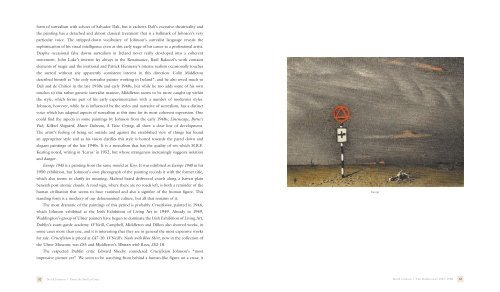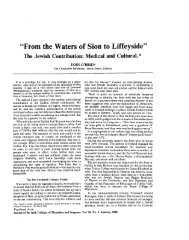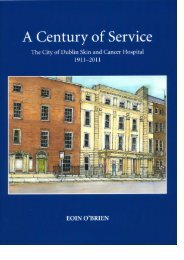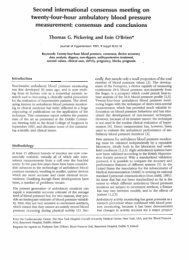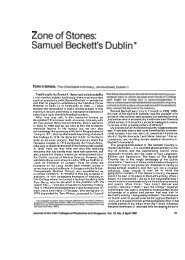Nevill Johnson: Paint the smell of grass - Eoin O'Brien
Nevill Johnson: Paint the smell of grass - Eoin O'Brien
Nevill Johnson: Paint the smell of grass - Eoin O'Brien
You also want an ePaper? Increase the reach of your titles
YUMPU automatically turns print PDFs into web optimized ePapers that Google loves.
form <strong>of</strong> surrealism with echoes <strong>of</strong> Salvador Dali, but it eschews Dali’s excessive <strong>the</strong>atricality and<br />
<strong>the</strong> painting has a detached and almost classical treatment that is a hallmark <strong>of</strong> <strong>Johnson</strong>’s very<br />
particular voice. The stripped-down vocabulary <strong>of</strong> <strong>Johnson</strong>’s surrealist language reveals <strong>the</strong><br />
sophistication <strong>of</strong> his visual intelligence even at this early stage <strong>of</strong> his career as a pr<strong>of</strong>essional artist.<br />
Despite occasional false dawns surrealism in Ireland never really developed into a coherent<br />
movement. John Luke’s interest lay always in <strong>the</strong> Renaissance, Basil Rakoczi’s work contains<br />
elements <strong>of</strong> magic and <strong>the</strong> irrational and Patrick Hennessy’s intense realism occasionally touches<br />
<strong>the</strong> surreal without any apparently consistent interest in this direction. Colin Middleton<br />
described himself as “<strong>the</strong> only surrealist painter working in Ireland”, and he also owed much to<br />
Dali and de Chirico in <strong>the</strong> late 1930s and early 1940s, but while he too adds some <strong>of</strong> his own<br />
touches to this ra<strong>the</strong>r generic surrealist manner, Middleton seems to be more caught up within<br />
<strong>the</strong> style, which forms part <strong>of</strong> his early experimentation with a number <strong>of</strong> modernist styles.<br />
<strong>Johnson</strong>, however, while he is influenced by <strong>the</strong> styles and narrative <strong>of</strong> surrealism, has a distinct<br />
voice which has adapted aspects <strong>of</strong> surrealism at this time for its most coherent expression. One<br />
could find <strong>the</strong> aspects in some paintings by <strong>Johnson</strong> from <strong>the</strong> early 1940s; Linenscape, Byrne’s<br />
Pub, Kilkeel Shipyard, Mater Dolorosa, A Voice Crying, all show a clear line <strong>of</strong> development.<br />
The artist’s feeling <strong>of</strong> being set outside and against <strong>the</strong> established view <strong>of</strong> things has found<br />
an appropriate style and as his vision clarifies this style is honed towards <strong>the</strong> pared down and<br />
elegant paintings <strong>of</strong> <strong>the</strong> late 1940s. It is a surrealism that has <strong>the</strong> quality <strong>of</strong> wit which H.R.F.<br />
Keating noted, writing in ‘Icarus’ in 1952, but whose strangeness increasingly suggests isolation<br />
and danger.<br />
Europe 1945 is a painting from <strong>the</strong> same mould as Keys. It was exhibited as Europe 1948 in his<br />
1950 exhibition, but <strong>Johnson</strong>’s own photograph <strong>of</strong> <strong>the</strong> painting records it with <strong>the</strong> former title,<br />
which also seems to clarify its meaning. Skeletal lizard driftwood crawls along a barren plain<br />
beneath post-atomic clouds. A road sign, where <strong>the</strong>re are no roads left, is both a reminder <strong>of</strong> <strong>the</strong><br />
human civilisation that seems to have vanished and also a signifier <strong>of</strong> <strong>the</strong> human figure. This<br />
standing form is a mockery <strong>of</strong> our dehumanised culture, but all that remains <strong>of</strong> it.<br />
The most dramatic <strong>of</strong> <strong>the</strong> paintings <strong>of</strong> this period is probably Crucifixion, painted in 1946,<br />
which <strong>Johnson</strong> exhibited at <strong>the</strong> Irish Exhibition <strong>of</strong> Living Art in 1949. Already in 1949,<br />
Waddington’s group <strong>of</strong> Ulster painters have begun to dominate <strong>the</strong> Irish Exhibition <strong>of</strong> Living Art,<br />
Dublin’s avant-garde academy. O’Neill, Campbell, Middleton and Dillon also showed works, in<br />
some cases more than one, and it is interesting that <strong>the</strong>y are in general <strong>the</strong> most expensive works<br />
for sale. Crucifixion is priced at £47-10. O’Neill’s Nude with Blue Skirt, now in <strong>the</strong> collection <strong>of</strong><br />
<strong>the</strong> Ulster Museum, was £55 and Middleton’s Woman with Roses, £52-10.<br />
The respected Dublin critic Edward Sheehy considered Crucifixion <strong>Johnson</strong>’s “most<br />
impressive picture yet”. We seem to be watching from behind a human-like figure on a cross; it<br />
32 <strong>Nevill</strong> <strong>Johnson</strong> l <strong>Paint</strong> <strong>the</strong> Smell <strong>of</strong> Grass<br />
Europe<br />
<strong>Nevill</strong> <strong>Johnson</strong> l The Dublin years 1947–1958 33


